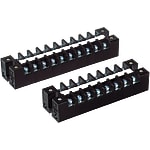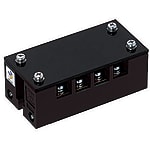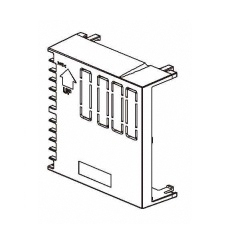(!)NOTE : Windows 7 users won’t be able to use some latest features of eCatalog/WOS since Microsoft is ending support for Windows 7 on 14 Jan, 2020. Please upgrade your system for uninterrupted services.
- Notice of End of Sales for Economy Series Pneumatic Equipment Category. More information.
Temperature Conditioning Components
Temperature conditioning controllers are widely used in a variety of machines, such as wire cutting machines, spot welding machines, X-ray instruments, and more. They come in various types, including Circulating Fluid Temperature Controller, Refrigeration Thermo-Chiller, Peltier Type Circulating Fluid Temperature
Temperature conditioning controllers are widely used in a variety of machines, such as wire cutting machines, spot welding machines, X-ray instruments, and more. They come in various types, including Circulating Fluid Temperature Controller, Refrigeration Thermo-Chiller, Peltier Type Circulating Fluid Temperature Controller, Thermo Controller (Air-Cooled), Thermo-Chiller Standard Type Water Cooled, and Terminal Block Unit, among others. These considerations are vital for ensuring the production of high-quality products. We highly recommend reputable brands like SMC and OMRON.
Take advantage of the convenience of FREE SHIPPING and NO MINIMUM ORDER on temperature conditioning and other related products. If you have any doubts or require assistance in choosing the right product, our experts are readily available to help.
Brand |
|
|---|---|
| CAD |
|
| Days to Ship |
|
5 items
- Sort By
-
You can add up to 6 items per a category to the compare list.




MISUMI
New at MISUMI? Get 20% Discount on your First Purchase. Click to Register Now
·This is a heat resistant terminal block. Choose from with or without a cover.- Volume Discount
From: ₹ 1,316.85 Days to Ship: 6 Day(s) or more  6 Day(s) or more
6 Day(s) or more
-
You can add up to 6 items per a category to the compare list.

Temperature Controller (Digital Control Meter) Option
OMRON
This is an option for the temperature controller.
[Features]
·For E5AK/E5AK-T: E53-C3
·For E5AN-H/E5EN-H: E53-C3N, E53-QN, E53-RN, E53-V34NFrom: ₹ 151.00 Days to Ship: Same day or more  Same day or more
Same day or more
-
You can add up to 6 items per a category to the compare list.

From: ₹ 22,966.00 Days to Ship: 5 Day(s)  5 Day(s)
5 Day(s)
-
You can add up to 6 items per a category to the compare list.
![Terminal Block Unit [E5DC]](//in.misumi-ec.com/linked/material/mech/OMR1/PHOTO/221006394636.jpg?$product_view_b$)
OMRON
- TERMINAL UNIT FOR E5DC from OMRON
- Part number for order E5DC-SCT1S
- This model is a saving space type.
- Terminal type: Screw terminal block.
- Removable Terminal Block for Easy Mounting and Replacement
- High-contrast displays enable easier confirmation regardless of ambient lighting conditions.
- Provide reliable and comfortable manufacturing for all people who deal with control panels.
- Mounting Adapter: Not include (Order Separately)
- USB-Serial Conversion Cable (Sold Separately)
- Operation temperature: -10 to 55°C
- Certification for CE, UL, and CSAFrom: ₹ 1,933.00 Days to Ship: 5 Day(s) or more  5 Day(s) or more
5 Day(s) or more
-
You can add up to 6 items per a category to the compare list.

Universal Relays - Soldered Terminal
MISUMI
[Features]·This is a solder terminal type universal relay.
- Volume Discount
From: ₹ 1,835.99 Days to Ship: 6 Day(s) or more  6 Day(s) or more
6 Day(s) or more
| Brand |
|---|
| Product Series |
| CAD |
| From |
| Days to Ship |
You can add up to 6 items per a category to the compare list. | You can add up to 6 items per a category to the compare list. | You can add up to 6 items per a category to the compare list. | You can add up to 6 items per a category to the compare list. | You can add up to 6 items per a category to the compare list. | |
| Brand | MISUMI | OMRON | OMRON | OMRON | MISUMI |
| Product Series | |||||
| CAD |
|
|
|
| |
| From | ₹ 1,316.85 | ₹ 151.00 | ₹ 22,966.00 | ₹ 1,933.00 | ₹ 1,835.99 |
| Days to Ship | 6 Day(s) or more | Same day or more | 5 Day(s) | 5 Day(s) or more | 6 Day(s) or more |
Loading...
Configure
Related Categories to Temperature Conditioning Components
FAQ Temperature Conditioning Components
- Question: What are temperature conditioning components?
- Answer: Temperature conditioning components are devices used in industrial settings to control and regulate temperature within a system. These components play a crucial role in maintaining optimal operating conditions for various equipment and processes. Common temperature conditioning components include thermostats, temperature sensors, heaters, coolers, and temperature controllers. They work together to ensure that machinery, processes, or environments remain within specified temperature ranges, preventing overheating or excessive cooling. These components are fundamental in industries like manufacturing, where precise temperature control is essential for product quality and process efficiency. Selecting the right temperature conditioning components is vital for achieving stability and reliability in automated systems, ensuring that equipment operates within safe and effective temperature parameters.
- Question: How do heat-resistant terminal blocks work in temperature control?
- Answer: Heat-resistant terminal blocks facilitate secure electrical connections in environments with high temperatures, commonly encountered in industrial processes. Constructed from materials that withstand elevated temperatures, these terminal blocks ensure stable and reliable electrical performance. By maintaining integrity in extreme heat, they contribute to the effectiveness and safety of temperature control systems, commonly used in industrial applications like furnaces and ovens where elevated temperatures are prevalent.
- Question: What is the purpose of Solid State Relays (SSRs) with heatsinks in temperature control systems?
- Answer: Solid-state relays (SSRs) with heatsinks play a key role in temperature control systems by precisely and reliably switching high-power electrical loads. The heatsink is essential for dissipating the heat generated during the switching process, preventing damage to the SSRs. This combination ensures the longevity and efficiency of the relay. In temperature control applications, SSRs with heatsinks contribute to accurate regulation of heating or cooling elements, enhancing system performance, responsiveness, and overall safety.
- Question: Can thermo-chillers be used for all types of temperature control applications?
- Answer: Thermo-chillers are versatile and can be used in various temperature control applications. They excel in maintaining precise temperature levels, making them suitable for processes like cooling in industrial equipment, medical devices, and scientific instruments. However, their applicability may depend on specific requirements, such as temperature range and cooling capacity, making it important to choose the right chiller for a given application.
- Question: How do converter modules enhance temperature control systems?
- Answer: Converter modules improve temperature control systems by converting and regulating electrical signals. They enable precise control of heating or cooling elements by adjusting power levels efficiently. These modules play a key role in enhancing the overall performance and responsiveness of temperature control systems. Their ability to convert signals ensures compatibility between different devices, facilitating seamless communication and enabling accurate temperature regulation in various applications.
- Question: What should be considered when selecting temperature conditioning components?
- Answer: When choosing temperature conditioning components, consider the required temperature range, precision, and compatibility with your application. Prioritize energy efficiency, reliability, and ease of installation and maintenance. Ensure components meet industry standards and regulations. Balance initial costs with long-term benefits, and assess scalability for potential system expansions. Choose components that align with your specific temperature control needs and application requirements.
- Question: Are there communication-enabled temperature control components?
- Answer: Communication-enabled temperature control components are advanced devices with built-in sensors and digital interfaces, allowing them to measure and regulate temperature. These components can communicate with other devices or central control systems using protocols like Modbus or Ethernet, enabling real-time monitoring and centralized control in applications like industrial automation and HVAC systems (Heating, ventilation, and air conditioning).
- Question: How do heat-resistant terminal blocks impact the stability of temperature control systems?
- Answer: Heat-resistant terminal blocks impact the stability of temperature control systems through their robust construction and capability to withstand high temperatures. These terminal blocks are typically made from materials with excellent heat resistance properties, ensuring they remain stable and functional in challenging thermal conditions. By providing a secure electrical connection even in elevated temperatures, heat-resistant terminal blocks prevent electrical failures, interruptions, or degradation, thus contributing to the overall stability and reliability of temperature control systems. This stability is crucial for maintaining precise and effective temperature regulation in various industrial and commercial applications.
- Question: What are the advantages of using SSRs over traditional relays in temperature control?
- Answer: Solid State Relays (SSRs) offer notable advantages in temperature control compared to traditional relays. With faster response times, longer lifespans due to no moving parts, reduced noise, and precise control over power, SSRs improve temperature regulation. They are compact, energy-efficient, and reliable. These factors collectively make SSRs a preferred choice for applications demanding accurate, efficient, and durable temperature control.
- Question: Can thermo-chillers be integrated into existing temperature control systems?
- Answer: Thermo-chillers can be effectively integrated into existing temperature control systems with careful planning. Compatibility checks, sizing assessments, and configuration of control interfaces are essential steps. Successful integration enhances the overall system's temperature regulation capabilities, allowing thermo-chillers to actively manage and control thermal conditions within the existing setup for improved efficiency and precision in temperature control across various applications.





![Terminal Block Unit [E5DC]](http://in.misumi-ec.com/linked/material/mech/OMR1/PHOTO/221006394636.jpg?$product_view_b$)




![Terminal Block Unit [E5DC]](http://in.misumi-ec.com/linked/material/mech/OMR1/PHOTO/221006394636.jpg?$product_view_c$)




How can we improve?
How can we improve?
Thank you for your time.
Your feedback is essential for our continuous improvement
Privacy Policy
Thank you for your cooperation.
Thank you for your time.
Your feedback is essential for our continuous improvement
Please use the inquiry form.
Privacy Policy